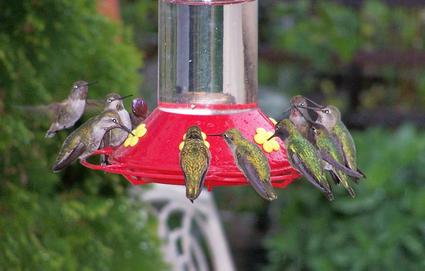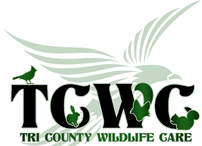 By Sandy Garcia, Tri County Wildlife Care We’ve watched their fancy moves and dives all spring and summer, and now there do not seem to be as many at our feeders and flowers. Where have these enchanting, remarkable little hummingbirds gone? The smallest and maybe most unique of all the birds, these little guys bring to us brightly colored plumage, intense activity, and the exceptional control of all their movements in the air. They can hover motionless as they drink from our feeders or suck up the sweet nectar in bright flowers, easily move any direction (forwards, backwards, up, down and sideways), and achieve their full speed in what seems to be an instant. They do not even need to slow down as they approach a perch, but just come in at their full speed and then abruptly stop. These little birds bring us many hours of pleasure and amusement. There are eight species of hummingbirds in North America, and we have six here in Amador County: the Allen’s, Anna’s, Black-chinned, Calliope, Costa’s and Rufous, with the Allen’s and Costa’s being a bit more rare. The feisty Rufous hummingbirds leave us each year in the fall and migrate solo to Mexico, which is why you are seeing a dip in activity in your gardens and at the feeders. The males return in the spring before the females so they can find the best territory and improve the chances of attracting the females for breeding, although they do not form pair bonds. The Rufous hummers claim possession of their feeding territory and spend much of their time sipping syrup and aggressively chasing away intruders, making the loud whizzing noises we hear as they dance around the feeder. Adult males can be identified by their reddish back with green scatters and green shoulders. Underparts are white with some reddish color. They also have bright green crowns and a brilliant scarlet throat. Females have a bright green back with underparts that are also white with rufous (reddish) on the sides. Their face is a dusky color and the throat is whitish, heavily marked with green to bronze. The Anna’s, weighing in at about 4 grams, do not migrate, so if you have a feeder out make sure to continually clean and refresh the syrup during the fall and winter and you will have hummingbirds all year long. Anna’s are the only hummers that sing during courtship and do spectacular aerial displays, looping back and forth in deep dives and vertical descents. They usually lay two tiny eggs in December and January in little nests bound together and fastened to trees and shrubbery by cobwebs. Anna’s can be identified by their iridescent bronze-green back, pale grey chest and belly, and green flanks. The adult male has a crimson red crown and throat which may look dull brown or grey without direct sunlight. Females have iridescent red throats though smaller and less brilliant than the males. Hummers usually live 3-4 years. Predators are not usually an issue with adult hummingbirds, although cats, small hawks, owls and praying mantis may catch and eat them. Ants and bees are not considered predators but are often after the nectar. You can keep an ant guard above the feeder, which is simply a tiny cup that holds water and the ants won’t cross over it to get to the feeder. There are several ways you can make sure you have hummingbirds around your home all year long. You can put up feeders, using packaged syrup or make your own using one part white cane sugar and four parts water. It is not necessary to boil, and you can store the unused syrup in the refrigerator for up to two weeks. Replace if the solution turns cloudy. You can also provide a hummingbird friendly garden, planting a variety of plants that flower during different times of the year. Hummers have no sense of smell so they are attracted to highly visible and nectar producing plants. Some favorites are: azaleas, honeysuckle, lantana, manzanita, morning glory, bee balm, foxglove, hosta, lupine, fuchsia, petunia, shrimp plant, camellias and wild blueberry. Make sure not to use pesticides. The hummingbird’s bill protects its long delicate tongue and aids its entry into a blossom to pump up the nectar. These little birds also eat insects for protein, often capturing them in flight. Make sure you provide them with convenient perching spots because they spend 80 percent of their time sitting on twigs, leafs, stems and such between feedings. Hummingbirds can provide you with many hours of fascinating enjoyment by providing them with safe havens for feeders and nectar producing plants. Enjoy their fearlessness, curiosity and aerial acrobatics. Tri County Wildlife Care, a local nonprofit started in 1994, is dedicated to the rescue and rehabilitation of our native wildlife and helping our community live in balance with wildlife. They envision a world where wildlife and people thrive together. For more information call (209) 283-EAGL (3245) or visit pawspartners.org. Copyright © 2015 Amador Ledger Dispatch
0 Comments
Leave a Reply. |
Archives
April 2024
Welcome!PawsPartners.org is an alliance formed between A-PAL Humane Society of Amador County and Tri County Wildlife Care, the latter serving native wildlife in Amador, Calaveras, and Eastern San Joaquin Counties. Since inception we have added the Shelter Partners volunteer group, who support our local Animal Control organization, and Amador County Animal Response Team (ACART). Categories
All
|
 RSS Feed
RSS Feed

